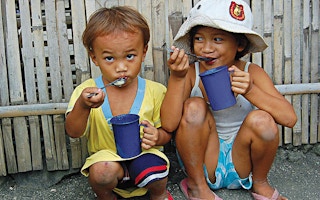Despite repeatedly faltering on the targets to reduce hunger, the global community renewed its pledge in 2015 to build a hunger-free world by 2030. Ironically, the number of food-insecure people has been increasing since then. In 2017 about 518 million people went to bed unfed or half-fed in Asia and the Pacific. In parallel, the challenges for farmers are increasing with economic and demographic transformations, and climate change.
Agricultural resources, including land, are shrinking and being increasingly claimed by other sectors. The farm workforce is decreasing as the incomes from other sectors including migration become more attractive and the youth are less interested in agriculture, making it a sector reliant on an aging population.
In this situation, doing more of the same will not resolve the challenge of Sustainable Development Goal 2: ending hunger and malnutrition by 2030.
Fortunately, the future does not have to be that gloomy. As always, science and technology provide solutions to these evolving challenges. ADB and the International Rice Research Institute, in partnership with a number of national research organisations, completed field experiments of two climate-smart and resource-saving technologies in Bangladesh, Cambodia and Nepal in 2019 to showcase scientific solutions to the problems faced by the agricultural sector.
In Bangladesh, alternate wetting and drying technology was used for comparisons with the continuous standing water irrigation system – the traditional irrigation method. In Cambodia and Nepal, direct-seeded rice technology was tested to compare with the traditional transplanted puddled system. In all pilot countries, vegetables were also cultivated between two rice crops.
The alternate wetting and drying technology, used in experiments in Bangladesh, required about 22 per cent less water compared to the traditional irrigation. Depending on the rice varieties and season of the rice cultivation, greenhouse gas emissions were 13 per cent–41 per cent less under alternate wetting and drying compared to continuous standing water irrigation.
This was achieved through reductions of periods of flooding of the rice field which in turns reduces the emission of methane. Yield of rice under alternate wetting and drying has either increased or remained at par with the traditional method of irrigation.
In Cambodia, mechanised direct-seeded rice technology decreased use of labor by 60 per cent–79 per cent compared to the traditional transplanted pu
“
Farmers in Asia face substantial challenges but climate-smart and resource-saving technologies give them a fighting chance of producing the food the region needs in a way that is both profitable and sustainable.
ddled system. It also increased the yield of rice by 26 per cent–50 per cent compared to the traditional transplanted system; and saved water by about 19 per cent‒32 per cent. Greenhouse gas emission was 68 kg/ha under direct-seeded rice compared to 98 kg/ha under transplanted puddling system.
In Nepal, direct-seeded rice technology combined with the machine-operated boom sprayer for plant protection and combine harvesting reduced the total cost of production of rice by 25 per cent compared to the conventional method. This technology also reduced the use of labor by about 83 per cent compared to conventional transplantation. Seed requirements decreased from 80 kg/ha under conventional methods to only 45 kg/ha under mechanised direct-seeded rice.
Overall, the income of the farmers increased by 52 per cent-61 per cent and the benefit–cost ratio increased by more than two-fold under these climate-smart and resource-saving technologies.
The results show that technology can lead to a shift from labor- and resource-intensive, to technology- and knowledge-intensive agriculture. This new paradigm will require less water, less workers, and emit less greenhouse gases to increase food profitably for farmers. This shift, however, would also face roadblocks.
Farmers’ lack of access to knowledge and technology is one of them. The appropriate approach, mechanism, and institutions to deliver the knowledge and technology to farmers are yet to be developed.
The key is to have a clear picture of the field to determine the suitability of a technology or combination of technologies to be promoted. There is a need to assess current practices, level of mechanisation, and availability of services. Appropriate technologies should be developed through field experiments and should be validated involving farmers in the process. The governments need to create an enabling environment for private companies to manufacture custom-designed machines to support the new production practices.
A smart extension service system should be developed to improve farmers’ access to information and knowledge. A platform involving scientists, farmers, private sector, and academia working together in partnership to support climate-smart agriculture will be useful.
In order to promote the mechanisation required for climate-smart agriculture, land consolidation at the production level is important. Governments should take measures to promote more voluntary land consolidation at the production level.
The majority of smallholder farmers are unable to own machinery by themselves to practice climate-smart agriculture. The private sector should be given incentives to set up hiring centers where farmers can rent machinery at a more affordable price.
Farmers’ cooperatives should be promoted as well to set up hiring centers. However, such cooperatives should be run following corporate principles, i.e., with a clear demarcation between equity holders and management personnel, all of whom should be accountable for their decisions.
Farmers in Asia face substantial challenges but climate-smart and resource-saving technologies give them a fighting chance of producing the food the region needs in a way that is both profitable and sustainable.
Akmal Siddiq is Chief of Rural Development and Food Security Thematic Group of the Asian Development Bank, (ADB), while Md. Abul Basher is Natural Resources and Agriculture Specialist, Sustainable Development and Climate Change Department.This article is republished from the ADB Blog.











